The Witcher Will Swing His Sword for One More Season
Published on April 18, 2024
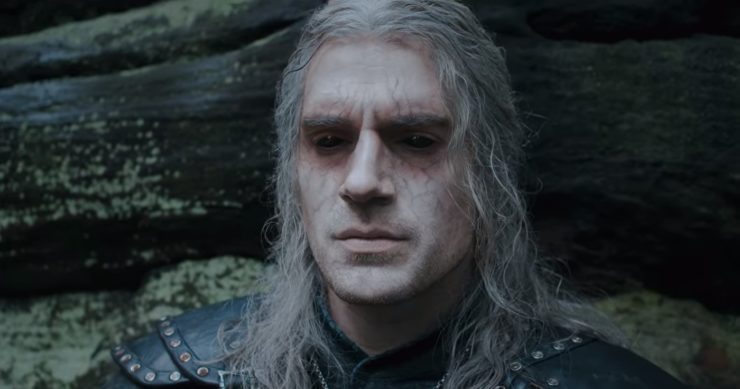
There’s good news and bad news, Witcher fans: The Netflix adaptation has been renewed for a fifth season, but that’s the last you’re going to get. And if you’re keeping Witcher-score, that means three seasons for Henry Cavill, and two for Liam Hemsworth, who steps into Geralt’s shoes for the currently-in-production fourth season.
The last two seasons will, according to Netflix, be filmed back-to-back, so presumably you won’t have to wait a number of years for the grand finale. And they will cover three of Andrzej Sapkowski’s books: Baptism of Fire, The Tower of the Swallow, and Lady of the Lake.
At this point, season four has a typically vague summary:
After the shocking, Continent-altering events that close out Season 3, the new season follows Geralt, Yennefer, and Ciri, who are separated and traversing the war-ravaged Continent and its many demons. If they can embrace and lead the groups of misfits they find themselves in, they have a chance of surviving the baptism of fire — and finding one another again.
Are there ever events in this show that aren’t shocking and Continent-altering? Creator and showrunner Lauren Schmidt Hissrich gave a few clues about what to expect, pointing at Vilgefortz and his betrayal. She told Tudum, “We want people to go back and start looking at all of the clues and breadcrumbs that we have laid out to see how these two people align. Because, clearly, there’s a lot more going on with Emhyr, Vilgefortz, and their past—and their future.”
Quite a few new faces are set for the upcoming season, including Sharlto Copley as Leo Bonhart and Laurence Fishburne as Regis, “a world-wise barber-surgeon with a mysterious past.” No premiere date has been announced just yet.[end-mark]
Transformers One is the Robot Origin Story No One Asked For
Published on April 18, 2024
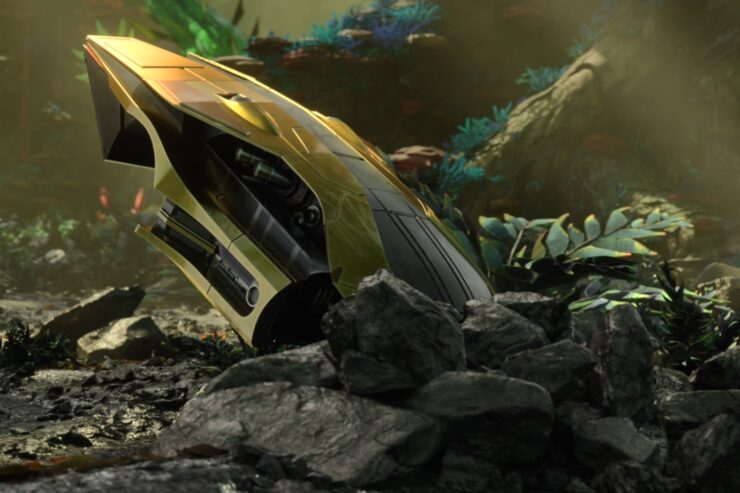
For years, now—years and years and years—the people have been crying out, not for more origin stories, but for them to stop. We have been origined half to death out here.
And if—if!—for some reason another origin story were necessary, you know what it wouldn’t be necessary for? Robots from the last century. Robots that are more than meets the eye. Robots that are going to say that tagline out loud in the trailer for the animated origin story Transformers One.
Hey, did you know Optimus Prime and Megatron were buds once? (What is this, the X-Men?) Did you know that they didn’t always know how to transform? Did you need to know that they were once lowly worker bots just like everyone else? Well. Someone thinks you ought to find out.
If your humble writer’s frustration with this inane commercial for robot toys seems a touch outsized, please consider this: The makers of this film saw fit to spend some unspecified but obviously quite large amount of money to shoot this movie trailer into space. Remember when space exploration meant something? Remember when we were curious about what was out there? You know what’s out there now? Transformers junk.
The actors providing the voices for this commercial film include Chris Hemsworth, Brian Tyree Henry, Scarlett Johansson, Keegan-Michael Key, Steve Buscemi, Laurence Fishburne, and Jon Hamm. Yes, despite the fact that we’re no longer in the ’80s, there is one token woman. Love that. Love that for all of us. Josh Cooley (Toy Story 4) directs.
For some reason, this movie is in theaters on September 20th.[end-mark]
Here We Go ’Round Again — Star Trek: Discovery’s “Face the Strange”
Published on April 18, 2024
Credit: CBS / Paramount+
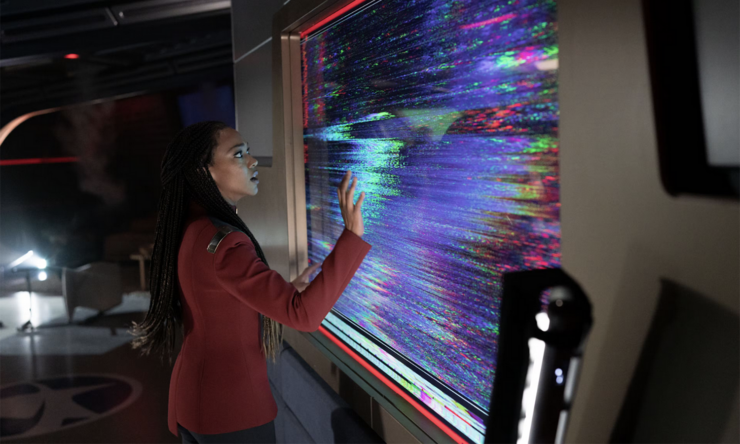
Credit: CBS / Paramount+
In its seventh and final season, Star Trek: Voyager did an episode entitled “Shattered.” The episode, with its title reminiscent of a Rolling Stones song, had Voyager split into different timeframes, where each section of the ship was in a different time, and only the present-day Chakotay and a past iteration of Janeway were able to move freely among the different time zones. It was little more than an excuse to visit bits of the show’s past (and one possible future), and even be reunited with a crew member who died (Martha Hackett’s Seska). Scientifically, the show made nothing like sense.
It its fifth and final season, Star Trek: Discovery has done something remarkably similar to “Shattered.” In this latest episode, with its title that is borrowed from a David Bowie song, only instead Burnham and Rayner are bouncing around to Discovery in different times and places, also visiting bits of the show’s past (and one possible future), and being reunited with a crew member who died. However, the science in this one actually takes a stab at plausibility (as plausible as time travel can possibly be). It even takes into account that Discovery is in totally different places in each time that Burnham and Rayner visit!
Okay, before we start, I have to mention something that I somehow completely missed last week at the very end of “Jinaal.” I managed to completely not notice that Moll (disguised as a Trill Guardian) slipped some kind of bug onto Adira.
However, I did notice it in the “previously on Star Trek: Discovery” re-showing of that scene at the top of “Face the Strange.” My initial thought was that it was a listening/homing device, but it was much more than that: it freezes Discovery in time, which apparently has effects throughout time and space.
(We see Moll and L’ak acquiring the bug from a dealer who tries to cheat them, but they anticipated that and poisoned the latinum they gave him and he dies. It shows that our bad guys are definitely very bad guys, but doesn’t really do anything to make our Bonnie-and-Clyde-in-space pair interesting, something that needs to happen soon.)
Discovery has two advantages, one inherent, one due to fortuitous timing. The latter is that Burnham and Rayner were trying to transport to the bridge right when the bug activated. Yes, after being reminded last week that, even in the thirty-second century, a “buncha rocks always beats centuries of technological progress,” this week we’re reminded that the transporter can seriously fuck shit up.
The inherent advantage, however, is a benefit, as Stamets, thanks to having tardigrade DNA, has a much more peculiar relationship with time and space than everyone else. This has already saved the crew’s asses on another occasion when they went on a wacky time-travel adventure, to wit, the Harry Mudd-induced time loops in “Magic to Make the Sanest Man Go Mad.” What’s more, Burnham knows this, and so she and Rayner seek out Stamets. Unlike Burnham and Rayner, Stamets is actually inhabiting his own body in each time jump, and going through whatever he happened to be going through at the time—including one occasion when he was really badly injured and about to go into a coma.
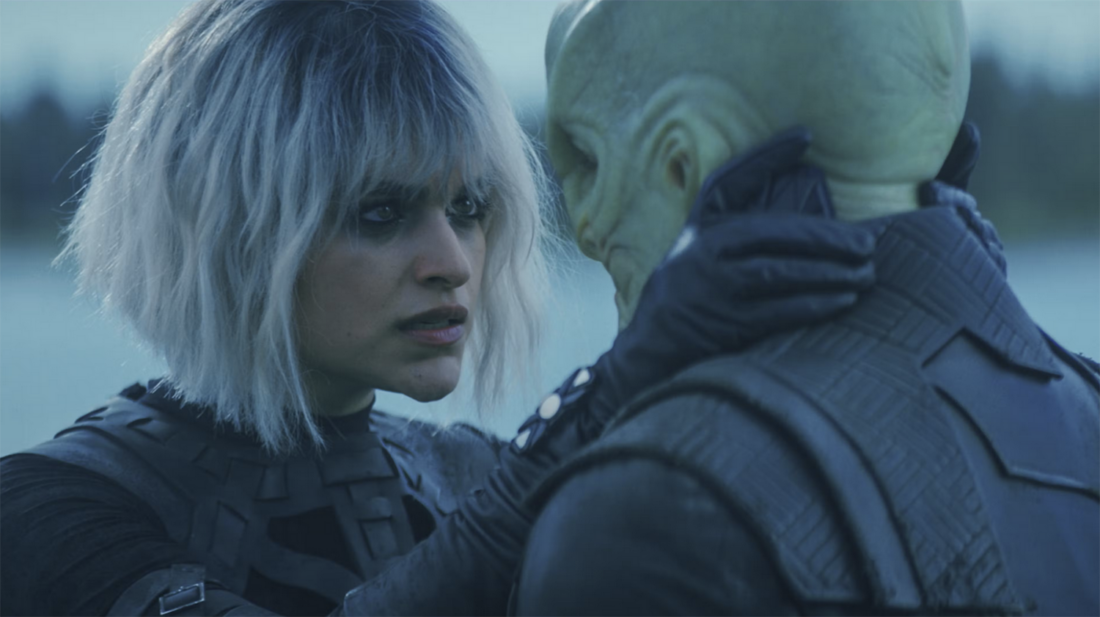
And when they go several decades into the future, everyone’s dead, because the Progenitors’ technology has been unleashed on the galaxy, and Burnham and Rayner show up to an empty Discovery, a slightly crazy Zora, and a destroyed Federation HQ.
This was the first of several minor disappointments I had with the episode. When Burnham and Rayner went to a future version of Discovery, I was really really really hoping that it would cross over with the Short Trek “Calypso,” maybe even with an Aldis Hodge appearance! But, alas, it was the “possible future” where Discovery doesn’t save the day and everyone dies. Which was another disappointment, because one of the things I liked about the quest for the Progenitors was that it wasn’t a Big! Major! Thing! That could destroy! Everything!
Except now it is. We got a hint of this when Jinaal told Burnham and Book last week that the tech killed one of his fellow scientists, and this week we get confirmation that if L’ak and Moll get the tech, it will destroy the heart of the Federation. It’s not quite the major threat that Control or the DMA were, but it’s still too fucking big a threat. It’s just tiresome, is all…
This episode’s reason for existing is mainly to get Burnham and Rayner to have their buddy movie, and for Rayner to come around to understanding how things work on Discovery and what kind of captain Burnham is. Because Rayner is an experienced captain in his own right, it’s a difficult transition for him. And it’s understandable. It’s incredibly hard to go back to being second-in-command after you’ve been the person in charge for so long. Plus, Rayner’s also adjusting to post-Burn life. The Federation was a different place during most of Rayner’s lifetime.
And, like “Shattered,” it’s also here to revisit some past storylines. We get them going back to the third season, when Burnham and Book are still a happy couple, and Burnham has to fake being someone who is still smitten with Book before she found herself forced into a place where she couldn’t trust him. And she’s reminded of the good times and that she loves him (and that David Ajala looks very good with his shirt off). We get them arriving when the Emerald Chain has taken over the ship, giving both Burnham and Rayner a chance to beat up some of Osyraa’s thugs. (One gets the impression that this is far from the first time Rayner has beaten up some Chain cannon fodder.)
During that bit, Rayner encounters Reno (Burnham hides at the sight of her). Rayner bluffs that he’s a temporary crew member, and Reno gives him a pep talk and makes him promise to buy her a drink at Red’s. Another minor disappointment: the episode didn’t end with Rayner buying Reno that drink.
The heart of the episode, though, is when they wind up on Discovery very shortly after Burnham came on board. She’s still a prisoner, trying to work off her mutiny conviction by helping Lorca. This is the longest they’ll be in one time zone, and it’s their best chance to destroy the bug (which is protected by a temporal force field, because of course it is).
Between them, Stamets and Burnham come up with a technobabble solution that requires Discovery to go to maximum warp and break through the warp bubble and then Rayner has to deactivate it as they break out of the bubble. It has to do with relativity and temporarily losing the protection against relativity that the warp bubble provides so that they can get through the temporal force field.
The problem is they have to convince the bridge crew to do it. Lorca, Saru, and Landry are off on a mission (because that would require getting Jason Isaacs and Rekha Sharma back, plus apparently this was an episode Doug Jones got off from having to be made up, as Saru only appears vocally over an intercom), so Airiam is in charge of the bridge.
Before Burnham can get to the bridge to convince the crew—including the one she saw die—to do her batshit plan, she bumps into herself.
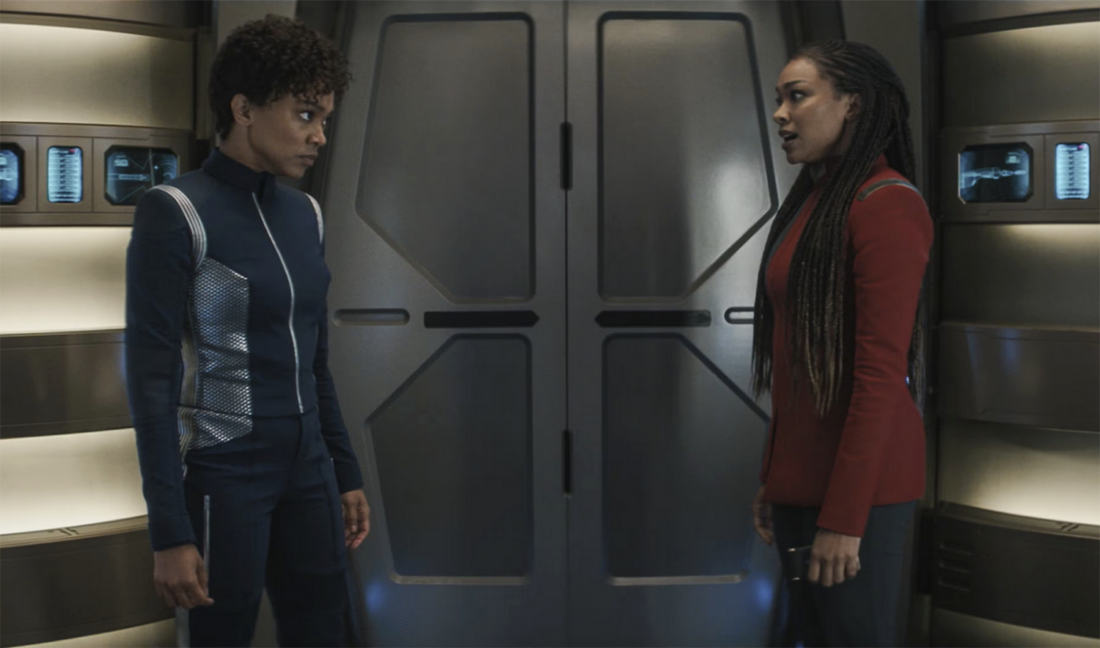
Which leads to another disappointment, as Prisoner Michael Burnham sees Captain Michael Burnham and assumes she’s a shapechanger or some other kind of violent life form, and fisticuffs ensue. And ensue, and ensue. It’s bad enough that the episode is riffing on the stupidest scene in Superman III, but it just goes on for-bloody-ever…
It’s fun seeing folks in the old uniforms, and in some cases in their old hairstyles—Burnham, Owosekun, and Tilly all get their first-season hair back for some scenes. And it’s especially nice to see Hannah Cheesman return as Airiam, and also Ronnie Rowe Jr. as Bryce. And you can tell that we’re back on Lorca’s Discovery (and they’re in the middle of a war), because everyone is angry and trigger-happy. When Burnham explains that in her future Airiam is dead, Bryce whips out a phaser and points it angrily at Burnham, refusing to believe that nonsense.
But Burnham is able to convince Airiam herself, which is what matters. They do the thing, the day is saved, and the timelines all reset thanks to plot-convenient-itis! That same plot-convenient-itis is how Burnham and Rayner manage to wander iterations of Discovery they don’t belong on with impunity and without being detected. At least they’re able to have privacy with Stamets mostly by Stamets declaring a “spore breach” and needing to clear engineering. Though early-first-season Stamets can just clear the room by being a grouch, as he was a lot snottier then…
Besides giving Burnham, and the viewer, a chance to indulge in some nostalgia, the episode also gives Burnham and Rayner a chance to do their little buddy movie, and Rayner starts to get the hang of the crew. In particular, he appreciates Burnham’s more free-spirited bridge more by the episode’s end. (My favorite is when he uses his knowledge of Rhys’ nerdity over starships in general and the twenty-third Constitution-class in particular, gained during his twenty-word meeting last week.)
My final disappointment with this episode is that we were told last week that they’d be going to Tzenkethi space, and I hoped that meant we would actually see the Tzenkethi for the first time onscreen. Alas, it was not to be.
Still, minor disappointments notwithstanding, this was a fun episode that didn’t exactly move things forward in terms of plot, but did fantastic work in doing it for character.[end-mark]
Man and Witch: The Dance of a Thousand Steps Trailer Gives Us the Fantasy Romcom We Apparently Need
Published on April 17, 2024
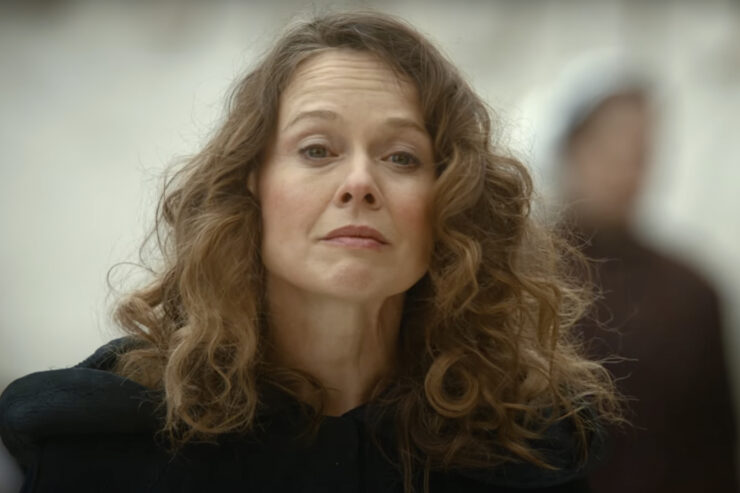
The trailer for Man and Witch: The Dance of a Thousand Steps suggests that the film is a fun fantasy romp, where a man goes to a witch to ask her to give him a wife, and the witch gives him three impossible tasks to do before she grants him his wish (which, I’m guessing, is that the two get together).
Here’s the official synopsis:
Tami Stronach, the iconic Childlike Empress in The NeverEnding Story (celebrating its 40th Anniversary this year), makes her long-awaited return to the big screen in the new fantasy film Man and Witch: The Dance of a Thousand Steps. When a lonely goatherd discovers that he has been cursed at birth to never take a wife, he makes a bargain with a reclusive witch to reverse the spell, only to find that if he can’t complete her three impossible tasks, he will never find true love.
In addition to Stronach, Man and Witch stars her real-life husband Greg Steinbruner as her co-lead, as well as Sean Astin, Christopher Lloyd, Eddie Izzard, Jennifer Saunders, Shohreh Aghdashloo, Michael Emerson, Bill Bailey, Daniel Portman, Stuart Bowman, and Martha West. It’s directed by Michael Hines and written by Steinbruner.
That’s quite an A-list supporting cast!
The film will be in theaters nationally only for a short time, on July 28 and July 30, 2024. You can learn more about the movie by heading to ManAndWitch.com.
Check out the trailer below. [end-mark]
Longlegs Wants You to Follow Some Spooky Clues Leading Up to Its Release
Published on April 17, 2024
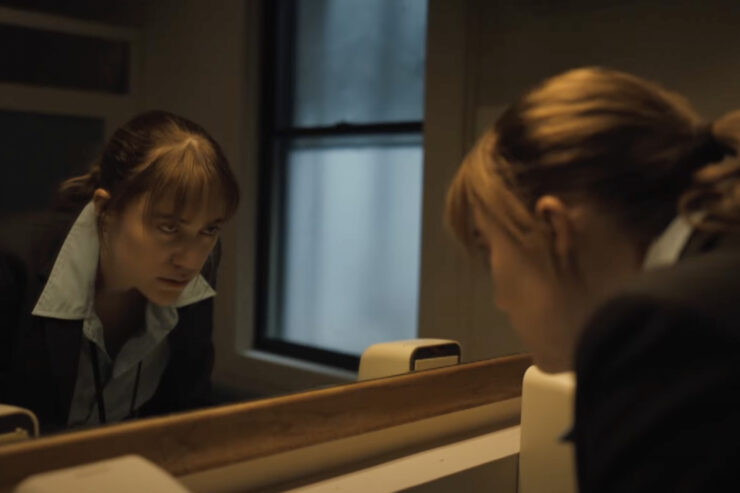
Neon, the distributor of the upcoming horror film Longlegs, is going all in on enigmatic marketing for the movie. Today, the company sent out a press release that was purposefully confusing and undoubtedly holds some secret code or something for people more motivated and/or clever than me to figure out.
Below is exactly what was shared in that email. Make of it what you will!
First, they shared this poster, titled “Sweet Part One”:
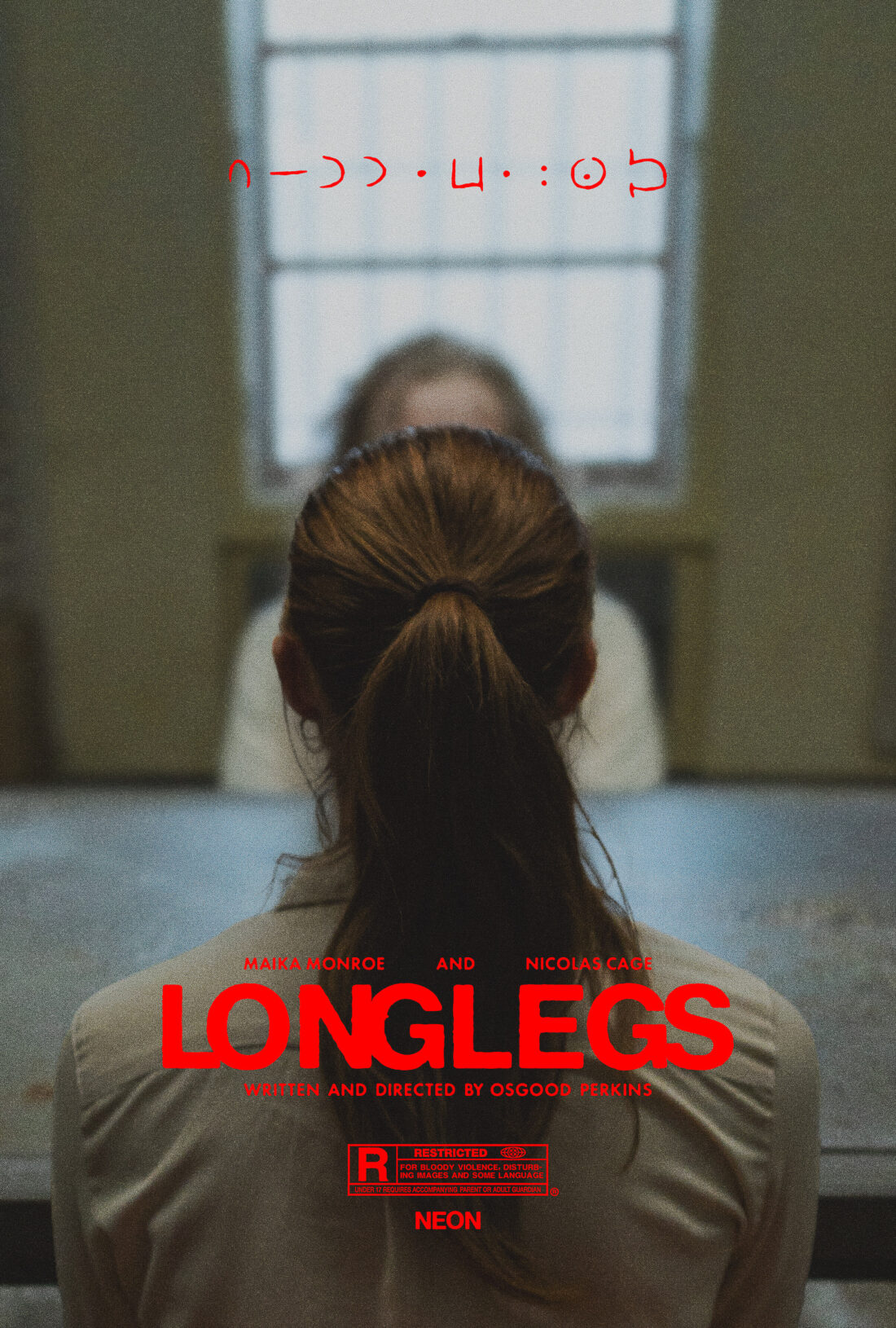
Then, they shared this teaser video, titled “Sweet Part Two”:
The clip is short, full of spooky scare vibes, and has a voiceover of a woman saying she never said her prayers because she was afraid to. There’s more there, of course, including some enigmatic phrases that I’m sure Mean Something and I invite you to watch it yourself and take notes.
Lastly, the email had the following “checklist”:
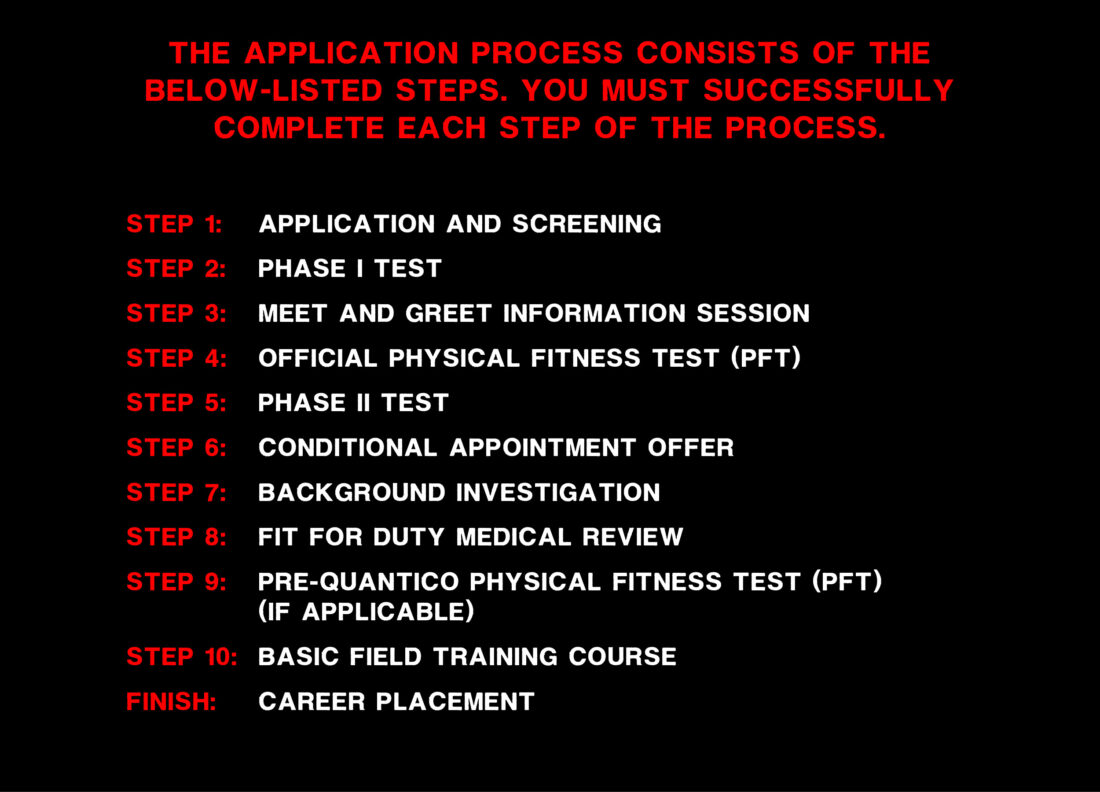
What does this mean? I have no idea! It seems like it’s a list for those who want to join or be recruited into… something? What that something is I have no idea, but I bet it’s spooky af.
Here’s what I do know about Longlegs. It stars Maika Monroe (It Follows) and features Nicolas Cage in an unknown role. It comes from writer-director Osgood Perkins, who is also the person behind the upcoming adaptation of Stephen King’s short story, “The Monkey.”
The film will hit theaters on July 12, 2024. Hopefully (probably) we’ll get more disturbing clues before then! [end-mark]
Five Superb SFF Fix-Up Novels
Published on April 18, 2024
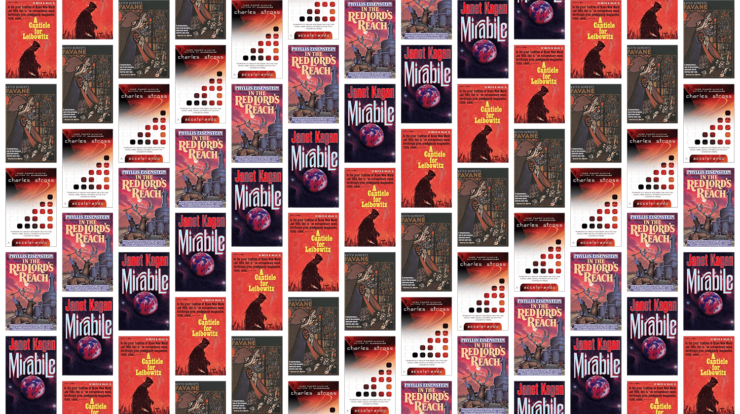
Suppose for the moment that you were a hard-working speculative fiction author with a lengthy backlist of short fiction. Further suppose that you wanted to package some of that short fiction into a collection that readers might buy. Imagine your consternation on discovering that collections weren’t selling well and that no publisher wanted to gamble on your work. What is a hard-working author to do?
One solution to a temporary shortage of funds is to don a garish costume, adopt a memorable nom de crime, and launch a series of unnecessarily complex schemes to rob banks. But there is an even easier solution! Simply take those unsellable short works, apply narrative spackle, and transform them into what A. E. Van Vogt called a “fix-up” novel. Readers will barely notice the seams as they enjoy your latest novel1. You will enjoy extra income. Everyone wins—especially your bank manager.
While Van Vogt’s own fix-ups were (to put it charitably) of variable quality, the form has produced legitimate classics that are well worth readers’ time and money. Herewith, five truly glorious fix-ups you might want to read.
Canticle for Leibowitz by Walter M. Miller, Jr. (1959)
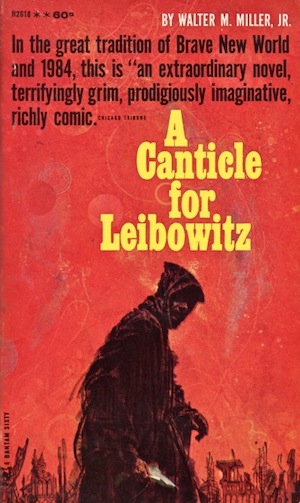
Miller’s only novel published during his lifetime, Canticle details the efforts of the pious brothers of the Albertian Order of Leibowitz to preserve scientific knowledge following the Flame Deluge and subsequent Simplification. The results are mixed at best, but the brothers’ hearts were pure.
The novel Canticle began as “A Canticle for Leibowitz,” “And the Light is Risen,” and “The Last Canticle,” all published in The Magazine of Fantasy and Science Fiction between 1955 and 1957. Each was substantially reworked before appearing as the fix-up Canticle for Leibowitz in 1959. The result was an instant, Hugo Award-winning classic. In fact, Canticle was so successful that it eclipsed Miller’s other work; I have encountered people who are entirely unaware Miller wrote other stories.
Pavane by Keith Roberts (1968)
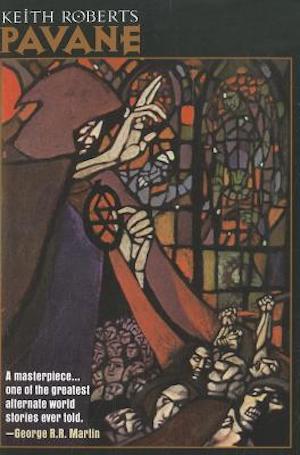
Following Queen Elizabeth I’s assassination, the Reformation is crushed. Spain remains ascendant. The Catholic Church remains the Church and technological and social innovation is discouraged. The consequences (and ultimately, the true cause) of this historical alteration are detailed over generations from the perspective of England’s Dorset region.
The novelettes that became Pavane began as “The Signaller,” “The Lady Anne,” “Brother John,” “Lords and Ladies,” “Corfe Gate,” and “The White Boat,” all published in 1966, all of which save “The White Boat” were first published in Impulse. “The White Boat” first appeared in New Worlds. As with Canticle, the result was an instant classic. While Pavane did not win a Hugo, it was featured in the first Ace SF Specials and is still in print over half a century later.
In the Red Lord’s Reach by Phyllis Eisenstein (1989)
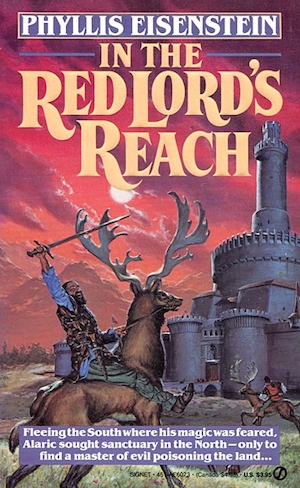
Alaric the Minstrel (bard and teleporter) gains employment in the Red Lord’s court. The mysterious screams heard from the Red Lord’s tower lead Alaric to question the prudence of working for the lord. A man who can teleport need not worry overmuch about imprisonment…but is Alaric the sort of man who will simply walk away from injustice?
Red Lord began as “The Land of Sorrow,” “The Mountain Fastness,” and “Beyond the Red Lord’s Reach,” all of which first appeared in The Magazine of Fantasy and Science Fiction between 1977 and 1988. Annoyingly, despite Eisenstein’s talent as a writer, both this volume and 1978’s Born to Exile are long out of print2. Alaric-curious readers can seek out Eisenstein’s more recent Alaric tale, 2014’s “The Caravan to Nowhere,” which may be found in the Rogues anthology edited by Gardner Dozois and George R.R. Martin.
Mirabile by Janet Kagan (1991)
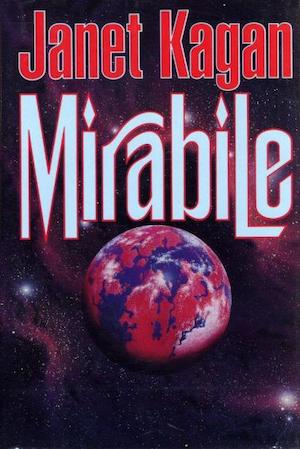
A mishap en route to an exoplanet cost the hopeful pioneers the index that was key to a cutting-edge biotechnological tool. Lack of index did not prevent genetically-engineered animals and plants from occasionally producing dissimilar, sometimes dangerous, offspring. It falls to Annie Jason “Mama Jason” Masmajean to deal with the resulting “Dragon’s Teeth.”
Mirabile’s composite parts—“The Loch Moose Monster,” “The Return of the Kangaroo Rex,” “The Flowering Inferno,” “Getting the Bugs Out,” “Raising Cane,” and “Frankenswine”) first appeared in Isaac Asimov’s Science Fiction Magazine between 1989 and 1991. As fix-ups go, the efforts to transform the original short pieces into a novel are perfunctory to the point that for years I thought it was a collection. Nevertheless, the result entertains. It’s too bad that Mirabile is currently out of print. Perhaps a letter-writing campaign to Mirabile’s publisher Tor could change that!
Accelerando by Charles Stross (2005)
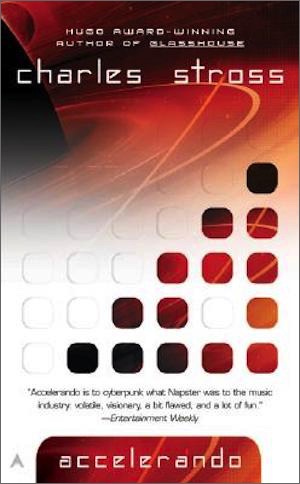
As was foretold by techno-optimistic futurists, the Singularity utterly transforms the world. A trifling side effect barely worth mentioning is that intellectually out-classed humans are swiftly reduced from Earth’s dominant thinkers to cognitive archaea. As detailed over generations, the post-Singularity era is an exciting time to be alive…or to be consumed by ruthless, super-intelligent AIs.
Accelerando’s component chapters (“Lobsters,” “Troubadour,” “Tourist,” “Halo,” “Router,” “Nightfall,” “Curator,” “Elector,” and “Survivor”) were all first published in in Asimov’s Science Fiction between 2001 and 2004. Accelerando was very well received; I don’t have the spare word count to list every award nomination that the fix-up and its parts earned. One wonders how Stross finds the mantlepiece space for all the awards. Accelerando can be downloaded here. Try not to burn out the servers.
Fix-ups are a venerable, respectable approach to writing and publishing speculative fiction. The five examples above are only a very small sample of a very large body of work3 [3]. No doubt I’ve missed some very notable examples. Feel free to lambast me for my omissions and correct my oversights in comments below.[end-mark]
- Seams are less obvious in fix-ups that were planned to become fix-ups from the beginning. One thinks of the many Victorian novels that were serialized and later collected into books. ↩︎
- As far as I can tell, anthologized stories aside, Eisenstein is completely out of print. I am astonished there hasn’t been A Complete Alaric, at least. The world found space to keep They’d Rather Be Right in print. Why not Eisenstein’s far superior books? ↩︎
- I seriously considered mentioning a certain fix-up first serialized in Analog way back in 1963 and 1965. However, the resulting fix-up was so unappealing to SF publishers that the author eventually settled for a publisher specializing in automotive repair manuals (an acquisition for which the purchasing editor was subsequently fired). Ultimately, I reluctantly deleted my discussion of that fix-up. After all, would 21st-century readers have even heard of Dune? ↩︎
Sweet Tooth Season 3 Trailer Heads to Alaska and Will Make You Cry (Probably)
Published on April 17, 2024
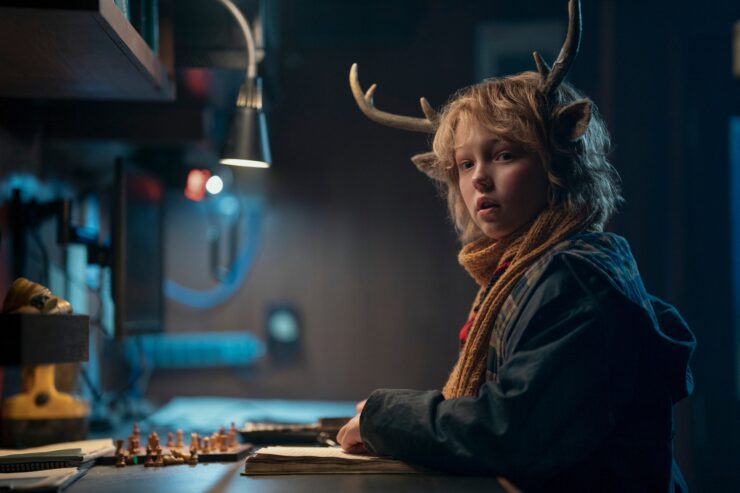
All roads lead to Alaska in the new trailer for the third and final season of Sweet Tooth, and it looks like things might get pretty dark for at least part of the upcoming episodes.
“Sweet Tooth showed me you got nothing to live for, until you got something to die for,” Jeppard says in the trailer. I’m sure that means that everything will be fine and nothing that makes you cry will happen.
Here’s the third season’s official synopsis:
Having defeated General Abbot in the battle at Pubba’s Cabin, Gus (Christian Convery), Jepperd (Nonso Anozie), Becky (Stefania LaVie Owen), and Wendy (Naledi Murray) embark on a journey to Alaska in search of Gus’s mother, Birdie (Amy Seimetz), who has been working to uncover the mysterious origins of the deadly Sick. Along the way, they are joined by Dr. Singh (Adeel Akhtar), who may have his own dangerous beliefs about Gus and his role in reversing the virus. Meanwhile, a new threat emerges in the form of Helen Zhang (Rosalind Chao), her daughter Rosie (Kelly Marie Tran), and the ferocious Wolf Boys, who seek to restart human birth and view Gus as the solution to their plans. As they navigate through perilous terrain, Gus and his group of friends find refuge at the Outpost in Alaska, where they meet a new ensemble of characters including Siana (Cara Gee) and her hybrid daughter Nuka (Ayazhan Dalabayeva). With the clock to find answers running out, alliances are tested and destinies intertwine, all leading to a thrilling climax that will determine the fate of humanity and hybrids.
“[It’s] another road trip story like Season One, but in a very different way,” showrunner Jim Mickle told Netflix’s website, Tudum. “Season Three is an Arctic story with exciting new adventures and what we hope will be a satisfying conclusion to this epic tale. Gus is going to see a side of the world and humanity that he didn’t see in Season One or Two.”
Tudum also confirmed that season three will be darker, and Mickle added that “in Season 3, everybody is dealing with some kind of wound or emotional loss, whether that was somebody in their life or a part of themselves. Everybody is looking inward and looking to move on and ultimately learning that life doesn’t stop. You have to keep putting one foot in front of another.”
The third season of Sweet Tooth premieres on Netflix on June 6, 2024, which gives you plenty of time to stock up on tissues.
Check out the trailer below. [end-mark]
For All Mankind Will Be Back for a Fifth Season—and With a Soviet Space Program Spinoff, Too
Published on April 17, 2024
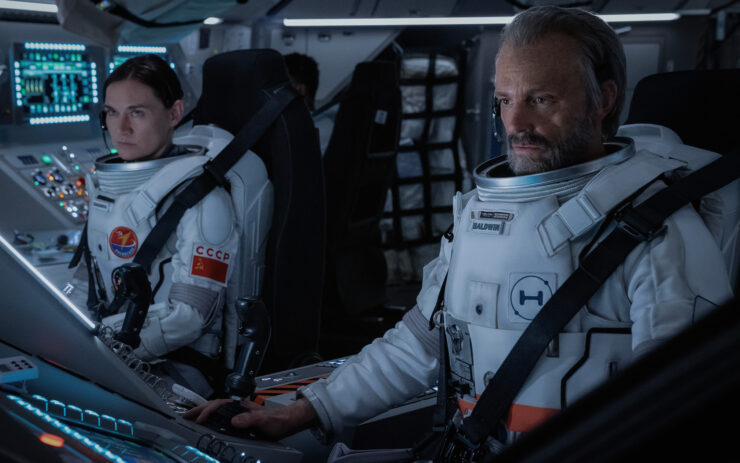
Space is still the place for Apple TV+, which has renewed For All Mankind for a fifth season. The series imagines an alternate timeline in which the Soviets won the space race—so it makes a certain amount of sense that the streamer is adding a spinoff series, Star City, that will explore the Soviet space program.
Two of For All Mankind and Star City’s three creators, Matt Wolpert and Ben Nedivi, will showrun the new series. (Presumably Ronald D. Moore will stay busy with the original show.) In a statement, Wolpert and Nedivi said, “Our fascination with the Soviet space program has grown with every season of For All Mankind. The more we learned about this secret city in the forests outside Moscow where the Soviet cosmonauts and engineers worked and lived, the more we wanted to tell this story of the other side of the space race.”
Apple’s official description of the new show says:
Star City is a propulsive, paranoid thriller that takes us back to the key moment in the alt-history retelling of the space race — when the Soviet Union became the first nation to put a man on the moon. But this time, we explore the story from behind the Iron Curtain, showing the lives of the cosmonauts, the engineers and the intelligence officers embedded among them in the Soviet space program, and the risks they all took to propel humanity forward.
No casting or timeline has been announced for Star City, and neither show has a premiere date. The first four seasons of For All Mankind are available to watch on Apple TV+.[end-mark]
A Golden Axe Animated Series Is Coming From Lower Decks Creator Mike McMahan
Published on April 17, 2024
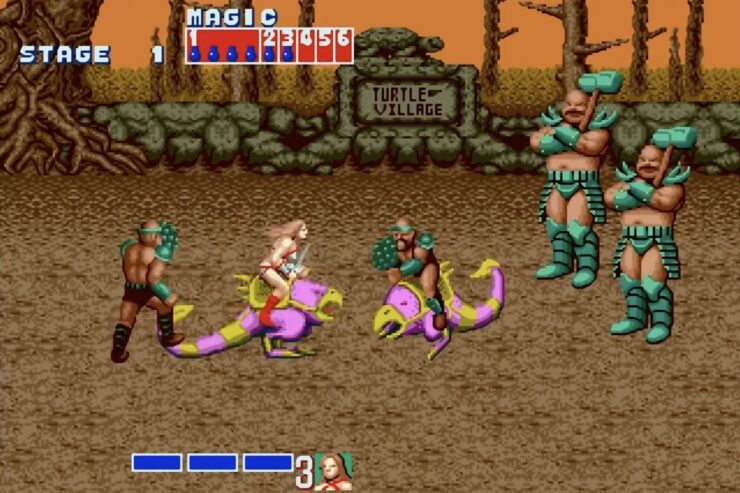
Have you had enough of video game adaptations? Too bad! Another one is coming down the pike—though this one is animated. Lower Decks creator Mike McMahan and American Dad producer Joe Chandler are teaming up for a cartoon version of Golden Axe, the side-scrolling Sega game in which good guys must save the magical land of Yuria from the evil Death Adder. Also, naturally, there’s a golden axe involved.
The voice cast for this obviously epic adventure includes Matthew Rhys (The Americans), Danny Pudi (Mythic Quest), Lisa Gilroy (Glamorous), Liam McIntyre (Star Wars: Resistance), and Carl Tart (Star Trek: Lower Decks). McMahan and Chandler are co-writing the show’s first episode; Chandler will serve as showrunner.
The official description, according to Variety, goes like this: Golden Axe “follows veteran warriors Ax Battler (McIntyre), Tyris Flare (Gilroy), and Gilius Thunderhead (Rhys) as they once again battle to save Yuria from the evil giant Death Adder who just won’t seem to stay dead. Fortunately, this time they have the inexperienced and underprepared Hampton Squib (Pudi) on their side.”
Hard to pick a favorite from those character names, but I think I’m going with “Ax Battler.” However, Gillius Thunderhead is a grumpy dwarf, Tyris Flare is a “battle sorceress,” and Tart plays a “humanoid panther,” so you can’t really go wrong no matter which fighter you pick. (Pudi’s character, on the other hand, is a “naive, inexperienced first time adventurer.”)
Comedy Central has ordered ten episodes of Golden Axe, but no premiere date has been announced.[end-mark]
The Kiddie Pool of Forever: Max Gladstone’s Last Exit (Part 18)
Published on April 17, 2024
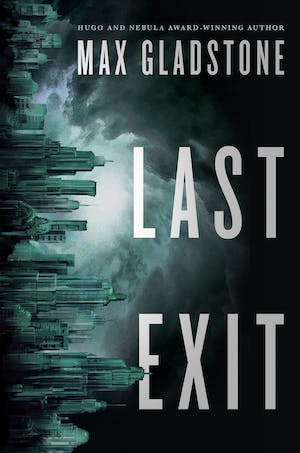
Welcome back to Reading the Weird, in which we get girl cooties all over weird fiction, cosmic horror, and Lovecraftiana—from its historical roots through its most recent branches. This week, we wrap up Max Gladstone’s Last Exit with Chapters 35-36. The novel was first published in 2022. Spoilers ahead!
Summary
“When you understood that there was something else beyond—that was when you realized just how much work there was to do.”
Desperate to get help for the gravely wounded Sarah and pursued by the cowboy, Ramon veers the Challenger off the alt-road into uncharted darkness. He is, at last, trailblazing.
On the newly blazed trail, the Challenger races down a steep hill to collide with an oak stump. Ramon, to his shock, finds himself still alive. He helps June ease Sarah out of the wreck. They’ve landed in a lakeside grove of sequoias. The night’s alive with the conversations of frogs, insects and birds; branches twist against the wind. Ramon senses he’s observed. “She needs help,” he says. Branches part. He is permitted.
He and June carry Sarah to the lake. For once, his knack doesn’t divine their location, so they’ll have to find their own way home. Can Sarah last that long? She’s so still that he can hardly tell if she’s swallowed the water he gives her, but they can’t lose her, not after Ramon has left the road, not after he’s asked. It has to make a difference. It has to matter.
June points to a sky overfilled with stars, some of them moving. Ramon thinks of shepherds and angels. Then Sarah says, “Aliens.” She’s awake and smiling. Through the hole in her blood-soaked dress, he sees that her gunshot wound has closed. “She did it,” June says.
Ramon feels paths open all around them, other spokes from the Medicine Wheel. Secret ways to other worlds await, lands beyond the cowboy, “beyond all borders and any map.” Ramon wants to follow them all. For now, though—
“Now,” June says, “we go home. And we get them ready.”
* * *
Two years pass. When it’s safe, Sarah drives her family from Virginia to New York. They’ve spent a lot of time inside, for the sky feels unimaginably big overhead, like it goes on forever. When you understand that there’s something beyond this forever, Sarah thinks, you realize how much work is left to do.
People repeat themselves a lot these days, as do the media, saying things are normal as if that makes them so. Nevertheless, people also tell stories about places that weren’t there when the world closed down, about shut doors now open, about statues that walk, trees that catch fire but don’t burn, lights in the woods, a dog ten years lost returning unaged. About what happened to them personally, people are more reticent. Sarah doesn’t blame them. She knows what’s going on but isn’t sure she believes it.
Ramon has emailed directions “precise as poetry”: Turn left at the dog, go until the sorrow hits you. New York seems like a maze, no, a labyrinth. In labyrinths, all paths lead to the center. Sarah negotiates the maze as if it were made just for her. Six blocks out from Ma Tempest’s house, the streets are so full that she and her family abandon their car. It’s a festival, not quite the Fourth of July. It’s folk of every age and color, speaking every language, singing, offering free cookies, barbequeing feasts. Sarah walks with a cane these days, and her body still aches as it accommodates itself to her injuries. Even magical healing has limits. What’s broken may mend, but it can’t be unbroken. There’s no undoing. There is going on, growing.
At Ma Tempest’s, people make a path for Sarah. There’s a grill going on the roof, but the group up here has a purpose. All around the city, many-colored flags rise and fall; young women with binoculars interpret this conversation, the city talking to itself, and call out answering codes. June is their leader. When she runs to Sarah, though, she’s almost a kid again. Ramon and his partner Gabe stand at the roof’s edge. Ma Tempest sits with folded hands, waiting and watching as she’s done for a long time.
Sarah’s just in time, June says. Can’t she feel it? Sarah feels something, but she’s been wrong before. So she asks, “What happens now?” It’s happening already, June says. It’s been happening. It will keep happening. They must just learn to ride it. Is Sarah scared?
“I used to be,” Sarah says. June smiles, but not at her answer. She’s rigid, as if listening for a sound only she can hear. At her word, the people fall quiet. Someone knocks on the door below.
June runs to the roof’s edge and shouts down: “Come on in. Come on in! It’s open.”
This Week’s Metrics
Fighting the Cowboy: Arizona State University’s Future Tense program uses speculative fiction to imagine alternatives.
Libronomicon: Sarah’s daughter Susan brings a tote bag to the Bronx, full of books to read and share.
Madness Takes Its Toll: The newspapers and TV doth protest too much about how normal everything is.
Anne’s Commentary
At the end of Chapter 34, we finally got to the fabled crossroads. Well, Zelda got to them, and Ish almost, oh-so-close. To be halted at the threshold of the alt-riders’ goal was his punishment for succumbing to the cowboy’s fear-tactics. It was also his last shot at redemption, which he took with unerring aim; in doing so, he achieved his personal goal of saving Zelda. He also saved his friends and contributed to saving his world. The cowboy dead, Zelda could climb the chain link fence between the black-flower path and the crossroads. She changed and grew, to meet Sal on Sal’s own ground.
It took Zelda long enough, as Sal said. That was so Sal, and you can’t blame her. Time is different in the alts, who knows how stretched out in the beyond. To paraphrase Sarah’s question to June in Chapter 36: What happens next? I just knew Chapter 35 would tell us, with suitable cosmic-level fireworks.
No. Instead of witnessing whatever BIG WORLD-RIGHTING MAGIC Sal and Zelda wield following their reunion, Chapter 35 returns to Ramon as he crashes the Challenger into one more damn tree. Luckily, it wasn’t one of the magisterial sequoias that ring his landing site—he and his passengers survive, though Sarah’s in no condition to hike home. Ramon forces himself to look at her wound, to find it healed! Somehow, perhaps through the jolt of Ramon’s trailblazing, she has gathered enough spin to heal herself.
Here’s the initial resolution for three of the alt-riders. Whatever else follows, they’re going home. From the vastness of space-time that separates them from the crossroads, they view the fireworks happening there. The crossroads are where BIG, FUNDAMENTAL CHANGE can happen, presumably due to Sal and Zelda’s combined spins. Anyway, new stars crowd the sky, “in all the colors whose names [Ramon] had ever forgotten.” Colors out of space, for real! Ramon thinks of angels. Sarah thinks of aliens, but she smiles, cool with the idea. June, recently as alien as shadow-Sal, has returned to her human, practical self. How much she’s changed awaits revelation.
Chapter 36 provides a tantalizing glimpse of a world also in flux. Sarah supplies the point-of-view. The physician’s healed herself, but magic only goes so far, leaving her with a limp and “cascade aches.” With an unresentful resignation she lacked earlier, Sarah accepts that what’s broken can’t be undone. It can, however, “mend, and grow again.”
As with Sarah, the world. Ish, who in the end loved his friends more than he clung to fear, has killed the cowboy. No, really: The cowboy seems to have departed from the earth, along with the crippling paranoia he promulgated. His death may have been the prerequisite for whatever BIG MAGIC took place at the crossroads. With the cowboy gone, people eventually dare to crack their defensive shells and notice the BIG MAGIC that was always there. Immediately after the change, people clamped their shells tighter than ever, self-isolating as against a pandemic. Venturing out again, Sarah notices that she’s “turned chatty.” People start gathering under the open sky, with barbecues as their excuse. They tell stories about magical happenings, though not ones that occurred close to home. Sarah hears no personal tales of the incredible, but she doesn’t blame people for their reticence. They have residual fear enough to insist that things are normal again, and for the media to echo the comforting idea. Sarah knows you don’t say something so often if it’s true. She knows things aren’t normal, but hey, even she’s not sure she believes it.
One epicenter of magical change seems to be the New York City area. People keep giving Sarah directions on how to skirt the NYC hot zone. She’s undeterred: Something big is about to happen there that she can’t miss. Ramon’s directions take her through a massive street party to Ma Tempest’s house. With Ish dead and Zelda and Sal elsewhere, it’s as much of a reunion as the alt-riders can expect. Sarah has come with her family. Ramon has come with Gabe. June is there, at home among the “switchboard” girls keeping the city connected and safe. Ma Tempest lets June play hostess. Her job is to sit and wait.
But to wait for what, or whom?
Of changes in the world at large, June tells Sarah, “It’s happening already. It’s been happening. It’ll keep happening, and I guess we’ll all just learn to ride it.” Echoing the words she spoke on the princess’s balcony, June adds that Sarah’s arrived just in time for a specific event, Soon after, she goes rigid, “one finger raised, as if straining to a sound only she could hear.” When she calls for silence, Sarah hears knocking on Ma’s front door, and June shouts down for the new arrivals to come in, it’s open.
Without telling who’s at the door, Gladstone ends the novel. Does he want us to make up our own ending, or (as I’m thinking) does he believe we’ve had enough clues to figure it out for ourselves? Whose coming would not be an anticlimax? Who can complete the reunion but Zelda, knocking as she did more than ten years ago, only to be repulsed? She’s not repulsed now.
And who could Ma Tempest be waiting for in such an attitude of long-endured loss? Sarah hasn’t come alone. Neither has Ramon. Why should Zelda, when among all the new wonders of the world, the greatest would be Sal, returned to her former humanity but mended and grown as all must be who’ve ever been broken.
Those who’ve never been broken need not come to the barbeque. Unless you bring those really good baked beans, now….
Ruthanna’s Commentary
This week I’ve been putting together our annual Passover seder—a ritual that if done right is mostly questions and arguments. If you’re not careful, though, even the questions become rote, the same year after year with no new answers.
When I try to articulate my reactions to finishing up Last Exit, I keep filling paragraphs with “maybe”. I suppose that’s appropriate, in a book about opening to possibilities—also, inevitably, about opening to doubt and uncertainty. Ish’s flaw was thinking that certainty solves everything, instead of just nailing doors shut. The whole gang takes a long time to admit that they might be wrong about the nature of the Rot. For Zelda, especially, that means admitting she’s been trying to solve the solution for 10 years, locking out the very potential for change that she originally wanted to invite in.
I don’t know why I expected to see what Zelda found on the other side of the fence. Thinking about it, I don’t see how one could reasonably write a scene depicting the things beyond what we can, tautologically, imagine. We do, though, get to see what Ramon and Sarah and June find by leaving the paved road: healing, and stars, and other directions. Aliens, maybe. Unconsidered possibilities, in whatever shape.
“Another world is not only possible,” says Arundhati Roy. “she is on her way. Maybe many of us won’t be here to greet her, but on a quiet day, if I listen very carefully, I can hear her breathing.” The alt-riders are a very particular set of people: broken and privileged and broken by privilege. The Princess was clearly much the same. Take someone with a different perspective into the alts and you get, well, June. Someone who won’t need long at all to question assumptions and look beyond the road and imagine what those wearing blinders cannot. Someone who won’t assume that tentacles and claws are as terrifying as they first seem, and who will see tools that aren’t the master’s tools.
What we see on the page this final week isn’t those possibilities, but the world’s response to them. Insistence on normality, and whispers about miracles—only the far away ones, though. Only the ones that aren’t too personal to talk about. Barbeques and poetic road trips. Street festivals and street medics. An imagined release from quarantine that’s as much spiritual as physical: more hopeful and open than the one we got, less shaped by the demands of employers and more shaped by the joys of the people. That choice, almost inevitable for a book written in the pandemic’s earlier days, is hard to read now. It feels like a future we’ve already missed. Maybe we can still get there by a different route, off the paved road and between the cracks.
It’s a harder route for us, because we haven’t lost our cowboy. You can’t actually shoot a story, even with its own bullets. People will keep telling it as long as they have reason. It’s a peril of incarnation, I suppose: national mytho-lies are written into every textbook and carved on every monument, but once you start possessing people with your hat, you’re taking a new risk. Maybe he’s gone back into the textbooks, but quiet enough for the moment to let a few new ideas leak through.
And to let people who’ve traveled in new directions come back, and knock on the door, and tell us what they’ve seen—just past the last page.
Next week, we wrap up National Poetry Month with the first five poems in Marisca Pichette’s Stoker-nominated Rivers in Your Skin, Sirens in Your Hair. Then, in two weeks, we start our new long-read, celebrating the 50th Anniversary of Stephen King’s first novel by… reading a different King novel. Join us for Pet Sematary![end-mark]
Steve Buscemi Joins Wednesday’s Season Two Cast
Published on April 16, 2024
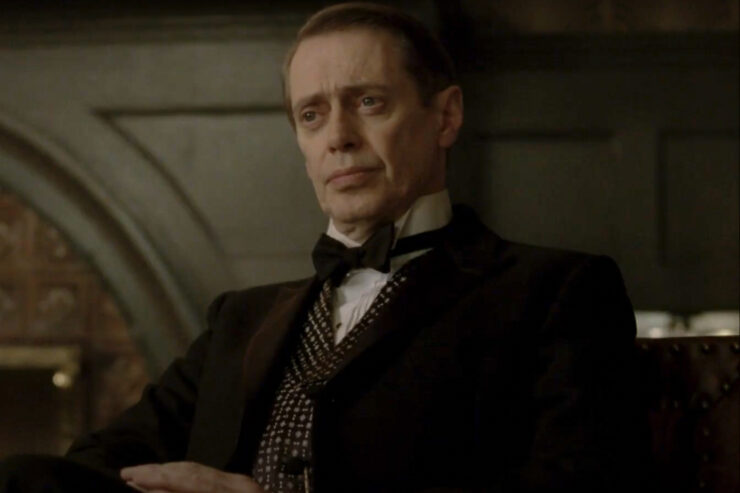
News about the second season of Netflix’s Wednesday has been sparse. We know that there is a Season Two in the works (no surprise there, given the success of the first), and that Jenna Ortega will be back as the titular character. Ortega has also hinted that the upcoming episodes will “lean into the horror” of the Addams Family and away from the love triangle teed up in Season One.
Other than that, details have been few. Today, however, Variety broke the news that Steve Buscemi (pictured above in Boardwalk Empire) has joined the cast. The trade didn’t have many details about his role except for one key thing: He will be taking over as principal of Nevermore Academy.
Spoiler warning!
I’m going to spoil events from Season One of Wednesday below, so bow out now if you don’t want anything revealed!
In the first season of Wednesday, the Nevermore Academy principal was Larissa Weems, who was played by Gwendoline Christie. Weems was a shapeshifter who was killed at the end of the season, leaving the role of principal open for someone else to take on. If Variety is right, Buscemi is that person, though who his character will be (and whether he’ll have any supernatural powers like Weems’ shapeshifting) remains to be seen.
It also remains to be seen when Season Two of Wednesday will premiere on Netflix, or whether the spinoff series centered on Uncle Fester is still a thing. The good news is we can rewatch the first season of Wednesday (again) while we wait for more information. [end-mark]
Read an Excerpt From S.K. Ali’s Fledgling
Published on April 17, 2024
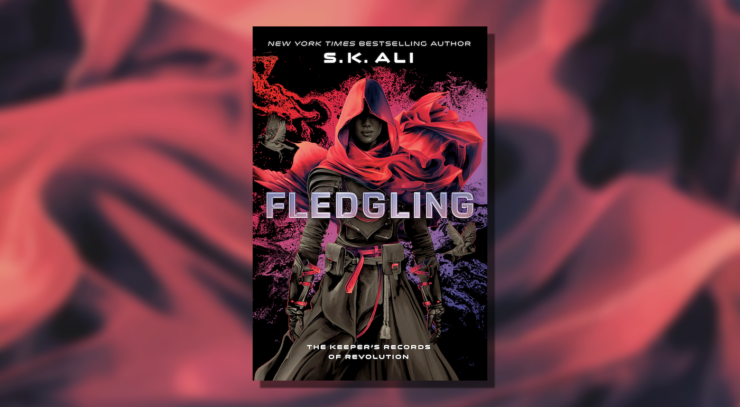
We’re thrilled to share an excerpt from Fledgling by S.K. Ali, the start of a new dystopian young adult duology—out from Kokila on October 8th.
Would you trade love for peace?
Raisa of Upper Earth has only lived a life of privilege and acquiescence. Ever dutiful, she accepts her father’s arrangement of her marriage to Lein, Crown Prince of the corrupt, volatile lands of Lower Earth.
Though Lein is a stranger, Raisa knows the wedding will unite their vastly different worlds in a pact of peace: an infusion of Upper Earth technology will usher in the final age of enlightenment, ending war between humans forever.
Or is justice more urgent?
Newly released from imprisonment, Nada of Lower Earth has found her own calling: disrupting the royal wedding.
Convinced her cousin Lein’s alliance with Upper Earth will launch an invasive, terrifying form of tyranny, Nada sets out undercover to light the spark of revolution.
When Raisa goes missing a week before the wedding, all eyes turn to the rebels, including Nayf, Nada’s twin brother, a fugitive on the run.
In Nayf and Raisa meeting, the long-simmering animosity between their worlds slowly burns away into something unexpected.
But the Crown Prince wants his bride—and future—back. And he will go to the ends of the earths to reclaim them.
For the future of our world, he has to fall in love with me. But at the party Papa orchestrated for this to occur, Lein has yet to glance my way.
Lein didn’t even look at me when we were first introduced, pride swelling Papa’s voice. “My daughter, Raisa. Raisa, may I present to you Crown Prince Lein, soon to be a guardian representing Lower Earth.”
With his hand firmly clasped in my father’s, Lein merely nodded at Papa’s announcement and then moved on—to shake hands with the other men in the receiving line, to lift the hands of the other women to his bent forehead, ever a model of perfect Upper Earth customs despite his Lower Earth breeding.
For the rest of the evening, my eyes trail him. I can’t help it. Papa prepped me for this introduction for months: I read the dossiers on Lein transferred by Alet, Papa’s assistant; I practiced the scripts Alet composed, full of warmth and wit, in attempts to win Lein over, in attempts to overcome my supposed aloofness when meeting new people. The latter task was hard work, to be truthful.
For ALIGN’s sake, I even deigned to dress in his favorite color.
But I’m left nursing an unsipped drink, wearing what Dame Kizuwanda assured me was a gorgeous dark emerald dress, standing at the outskirts of the party alongside whoever makes their way to me, my eyes darting to find him again and again as he flits about the hall, laughing with some, speaking low and serious, head bent, with others.
I locate him easily whenever he pauses to scan the room before moving on with purposeful long strides to work another corner of the Visionaries Ballroom, built in the stuffy baroque style of centuries past.
Never, in any of those sweeping scans, does his gaze register my presence in the slightest.
“Raisa, you’re not listening.” Suzume tilts her head—I can’t tell if it’s to check the left side of my forehead, to see whether my link is activated, or if it’s in judgment. “It’s a scalplink-off event.”
“I’m not knitted.” I keep the unease from my voice—access to the information a scalplink provides would make this event easier to navigate. But our social events are increasingly scalplink-free to encourage stronger connections between us. I don’t bother to tilt my own head to prove to Suzume that my link is idle.
She holds back a laugh. “I was hardly suggesting you were.”
“You were talking about pomegranates.”
“Did you notice the lack? No trace of pom in our drinks, no pom molasses dip for the amuse-bouche. How can this be the status at the Autumn’s Eve Gala? All the guardians are here, and not just the Uppers.” She leans over to whisper, the long trails of tiny diamonds on her scalplink falling over one eye like shimmery bangs. “Even the new guardian of Lower Earth is here. If the council itself and their guests cannot be provided with offerings from the best of the harvest, what does that mean for the rest of us.” She ends in her typical way of speaking, a question uttered flatly, unquestioningly.
Buy the Book
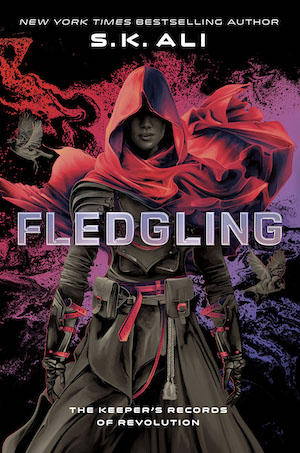

Fledgling
I nod, keeping my opinions to myself. Suzume is my closest companion—I would never say confidante—and she knows better than to ask such questions with any note of inquiry.
She knows that as I’m the chief guardian’s daughter, I likely know the reasons behind every decision made for this gathering, or any others organized by the guardians. Perhaps she’s waiting for me to slip and reveal a small kernel of truth. But I only reveal what my father tells me to, intentionally planted seeds of information—or misinformation—that strategically spread from Suzume through the upper echelons of our society. I absolutely know that our carefully managed Upper Earth existence will only last at the most twenty more years, that the future of the Bridge, the land mass on Lower Earth that we’re connected to, is projected to be even shorter—perhaps another decade. That all the years of working to establish peace and safety on the remnants of our planet after the Great Catastrophe are being undone by this latest agitation by the brutes of Lower Earth, growing in severity and violence in the last ten years.
Our food security is under the greatest threat at the moment as the brutes double their efforts to disrupt the flow of goods from Lower Earth farms to the Bridge processing plants and launch sites, gleefully seizing on this horrendous way to hurt us.
Crown Prince Lein’s father, Amir Gauis, not at the gala, governs Lower Earth but with increasing ineffectiveness. After a short period of iron-fisted rule when the agricultural and mining operations were in full swing, he gradually lost hold of the small towns and villages of Lower Earth. Forget about the mission to track and control the brutes—that fell to us in Upper Earth and the Bridge, to our commissaries, our experts, our spies. A drunkard and womanizer, the dossier on the palace revealed, Amir Gauis lives in a constant state of stupor, only revived by the periodic smuggling of new women into the palace or his excursions to visit the bride markets. His rulership, once seen as a hopeful replacement of the previous leader, is now a security threat to ALIGN. Resources and support must be shifted to his son Lein, who, by all accounts, is more sophisticated in both lifestyle choices and world views.
The sophisticated Lein is now laughing at something Moineau just shared, her porcelain-smooth face upturned to his own olive-tinted one. He appears taken by her, which isn’t surprising.
She’s a tiny thing, aptly named sparrow in French, one of the three languages of Upper Earth. She tells everyone she meets everything in her brain, which are often quite fanciful observations connecting the happenings around her with something she just read. She reads a lot. I wonder if her scalplink, dressed up tonight via stems of gold reaching to the center of her forehead, is idle now, or whether it’s offering facts to share with a rapt-faced Lein.
I recall what I read this morning: Lein has great respect for the accruement of knowledge. He believes in access to information for all. He is committed to the importance of knitting the population of Lower Earth into the streams of civilizational scholarship ALIGN has preserved. He believes in the immediate implementation of the Enlightenment Project.
“He doesn’t appear to have Lower Earth ways, that’s certain.” Suzume is also observing Lein now, as he continues to bestow Moineau with amused attention. “I would have sworn he grew up here with us. His manners are beyond reproach.”
We watch Lein’s face—dark eyes under dark groomed eyebrows, a straight nose, and a wide mouth, one that bursts into smiles just as easily as it closes into a thoughtful line, framed by an impeccable jawline and a high brow—transform as he leans closer to Moineau. She puts a hand on his arm and says something into his ear earnestly, at which he draws away to indulge her in a beautiful smile. Even from across the room, I can read what his lips say in response. “I’ll keep your secret, not to worry.”
Moineau is also wearing green; but hers is a short, sleeveless, simple sheath that emphasizes her ingenuousness. It’s not like the long fulsome gown I wear on my tall frame. The dossier suggested Lower Earth men prefer outward modesty.
Moineau may beg to differ with the dossier.
I suddenly feel stuffy. The gown I’m wearing at first felt elegant and now feels overdone.
A gaudy ornament hung among refined jewels.
The familiar fear washes over me again: I am a pretender in this world.
I leave the cheery sounds of tinkling glasses being lifted from or set back on serving trays, lilting laughter, buoyant conversations, the full orchestra providing a symphonic background to it all, and find my way to the Hall of History, quiet and dead.
Unknitted, I feel the panic coming on: I’m failing at Papa’s assignment, failing at securing our future. Simply failing, like I always seem to do.
* * *
From my earliest memory, I knew I was different, and those differences were shortcomings on Upper Earth. Though I tried to mimic the other kids as much as possible, my efforts were to no avail.
I couldn’t ever achieve their sunny, even-keeled dispositions. I couldn’t ever accept the losses that came my way without throwing a tantrum, without bursting into tears and descending into depressive episodes, without acting out my frustrations. I cannot lie and say my peers rejected me; that wasn’t true. They loved me through my maladjustments—but not because they were saints, nor because I was lovable.
It was because of my mother. She was the first pre-centenarian term death recorded in Upper Earth files, having died at thirty-three, when I was nine years old. No one else here has had anyone die so early in their families.
I sit now on the sole bench, a round orange one, in the middle of the Hall of History and activate my scalplink with three rapid blinks. The bare gray walls come to life, and I flick my fingers in the air to find the beginnings of recent history. I zoom in on the part of Earth called the Bridge, the inhabitants of which joined an alliance with Upper Earth ten years ago.
When I was nine and my mother was thirty-three.
I watch the explosion with morbid and philosophical fascination—how can anyone extinguish human life without a second thought?
My mother was killed by the brutes who took the air carrier she was in hostage, as a way to disrupt the merger of the Bridge and Upper Earth, to prevent ALIGN from growing. I’d already gone up to Upper Earth with Papa, while my mother had stayed behind to help with the process of knitting Bridge residents into our systems. They blew her up on her way to join us.
My scalplink, attuned to my bewilderment on this topic, feeds me background by providing the brutes’ ethos: The brutes despise our way of life. They detest our freedoms. They fear the equality of men and women, and they reject the fraternity of all people. They despise ALIGN.
I wonder if this is where the seed of my disturbance was planted: in the story of my mother’s death. Papa said the brutes were angry because they believed my mother was a traitor: Since she was born into a family on Lower Earth, her work to increase the scope of ALIGN was a betrayal.
I also wonder if my temperament is because I’m not purely of Upper Earth, like Papa is, like most everyone around me is. Because I am of Lower Earth too.
Because working extra hard to show up with the “natural elegance” expected of me is exhausting, and sometimes I just can’t do it any longer.
But those wonderings are surface ones.
I turn off my scalplink and slide it off my head completely, feeling my jaw slacken as the probe loosens its connection to my left temple. Cradled in my hands, the green jewels Dame Kizuwanda clipped onto my link for the event sparkle in the recessed lights running along the edges of the ceiling.
The truth is something I can reflect on only with my scalplink off, in case Papa sees the extent of my anguish. He often checks in on my emotional state if I’m knitted.
He can’t know.
He might not trust me again with the tasks he assigns me, tasks that affirm his belief in me, that he doesn’t hold me responsible in any way for—
I’m a mess inside because my mother died because of me.
She was meant to stay longer, finish her mission on the Bridge, wait to board a heavily fortified carrier from the Council of Guardians, but because I’d cried every passing day, begging for her to join us in Upper Earth, which was then a strange new world for me, she left earlier.
She died in compliance of my yearning for her.
She no longer lives, because I couldn’t live without her.
* * *
But I must remember I still have Papa.
And Papa has a plan: Once Lein agrees to a strategic marriage with myself, Raisa, daughter of Aeon, the chief guardian of the Council of Guardians of ALIGN, a child of both Earths, we will tour Lower Earth to celebrate our wedding and to usher in Enlightenment, the process of transferring the knowledge streams into the inhabitants below via scalplinks.
The final hope for peace: the rest of humanity knitted into the ALIGN system willingly.
Since my mother’s death, this has become my primary fascination, the focus of my life: I want to finish my mother’s work for peace—the work I cut short with my cries for her.
The first step toward my goal is through Lein’s heart.
Birdsong floats from the Visionaries Ballroom, announcing dinner. Recorded birdsong, as, while many bird species survived the Great Catastrophe, there are none that could live so high on Upper Earth—though many attempts were and are still made to bring them up here. People buy them in cages from the Grand Market on Lower Earth, in hopes they’ll be the lucky ones to keep them alive.
But they all end up dying eventually. And our scientists have never been able to breed them in the atmosphere artificially engineered to sustain us and our other pets.
Birds flying free are the only things we miss in Upper Earth, and so everything avian is highly prized.
As the chirps from the ballroom die down, I slide my scalplink on and activate it, a momentary but necessary rebellion, and brace myself for the zing of conduction, the probe rejoining my mind. It always takes a few seconds to get used to the linking pressure, but as soon as it happens, my spirit lifts as it reconnects me to the world.
Back on, I quickly switch my scalplink to mirrormode and look at myself on the wall across from me in the Hall of History, while knitting into the palace dossier to prepare myself to be in Lein’s vicinity again at dinner.
Lein likes petite and fair women. His last love interest, Clure, had blond hair and blue eyes, a small nose, and a rosebud mouth. He would have made her his partner if it weren’t for the fact she was a castoff from one of his father’s bride-market purchases. He understands the peril this brings, to introduce instability into his bloodline, as his constituents in Lower Earth would see it. He is aware of the need for a propitious match.
My skin is brown; my mouth is full; my nose is long; my stature is tall and healthy. I look like my mother, and I won’t apologize for it. I straighten and blink thrice to flick my scalplink idle before making my way to dinner.
* * *
I sit across from the eldest Upper Earth guardian on the council, Wilfred, 120 years old. On the way in, I saw a switch had taken place—instead of my nameplate, the charming Moineau’s now sits across from Lein’s spot.
I can’t imagine poised Moineau doing such a thing—it must have been him, completely besotted by her—so I ponder taking a moment to turn my scalplink to thinkmode to record the failure to secure this evening’s goal. Perhaps if Papa knows the loss of this opportunity early, we can try some sort of intervention before dessert.
I glance to the head of the lengthy table, where Papa presides, with the head guardian of the Bridge at his right arm, and after him the other Bridge guardians are seated in order of importance. Papa’s hair whitened when my mother died, and now it hangs neatly combed back from his head, falling slightly wavy to his shoulder. His beard, similarly white, is trim and edged precisely. He sees me and smiles encouragingly, blue eyes crinkling at the edges like they always do the moment they land on me. I smile back but look away quickly, afraid to reveal too much in front of guests.
Maybe I should have saved my thoughts; the way I broke Papa’s gaze just now, he’s sure to check my thinkmode stream immediately to see what I’m upset about. He can’t stand to see me hurt. He often reminds me, Always record your feelings in thinkmode, so you can be helped to feel optimally at all times. We don’t need to waste time on unproductive emotions.
Lein is standing, tucking in his dining chair.
He makes his way behind the line of diners sitting, chatting, preparing themselves happily—flicking out napkins, straightening cutlery—for the arrival of the first course. I don’t care that I’m staring keenly. Maybe even shamelessly. I might make a bad spy, but I will never lose sight of someone I’m trailing.
He stops behind Wilfred’s chair. He bends and whispers a few words into the old man’s ears.
Wilfred gets up from his seat, holding his nameplate. Lein sets his nameplate down.
Across from mine.
Then he finally looks me right in the eyes. Smiles a smile I haven’t seen yet at this party.
“At long last, I get to have some time with you,” he says, his voice thrillingly low and smooth, superb, a tone it seems made only for me. “I’ve been waiting for this moment all night, Raisa.”
Excerpted from Fledgling, copyright © 2024 by S.K. Ali.
What The Sparrow Got Right About the Future — And What It Missed
Published on April 17, 2024
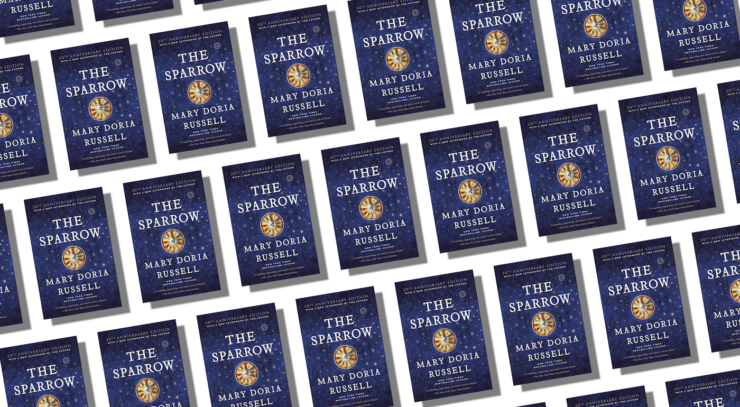
In 1996, Mary Doria Russell’s debut novel, The Sparrow, was released to strong reviews and multiple awards including an Astounding Award for Best New Writer, an Otherwise Award, and an Arthur C. Clarke Award. The book tells the story of Father Emilio Sandoz, a Jesuit priest and linguist who is the only surviving member of a mission to the planet of Rakhat—the first voyage Earthlings have ever made to another inhabited planet. After Emilio comes back to Earth, he faces a tribunal to explain what happened to everyone else. The Sparrow is a fascinating, troubling, often heartbreaking work of sci-fi. While not all of it has aged perfectly (there are a lot of broad cultural assumptions made) its exploration of faith and first contact is still extremely moving.
The book jumps between several different time periods: 2014-2019, when Emilio Sandoz meets the people who become his best friends and eventual crew on the mission to Rakhat; 2020-2022, when the crew travels toward Rakhat; the nebulous time on Rakhat, which would have felt like a few years in the mid-late 2020s to Emilio and his crew, but is the equivalent of about 40 years back home; and 2060, when Emilio returns as the sole survivor of the mission. Because of these time jumps, we get to see quite a bit of Russell’s imagined future.
Inventing a future is always tricky. You can end up with a situation like Super Sad True Love Story or A Visit from the Good Squad, where the worldbuilding is solid but you also have to invent teen slang and trends, when teen slang and trends are the most changeable things in the world and no one can ever possibly get them right. You can end up in the Infinite Jest situation, where the author puts all his chips down on one particular piece of tech—in this case “cartridges”—and makes them a fulcrum for his plot, only to watch the rise of discs and then streaming make his vision of the future seem impossibly retro. Russell ducks a lot of these issues by making most of her characters priests, and sequestering them in a couple of specific locations—in one case, a newly-discovered planet; in the other, a rural Italian retreat house—where slang and internet trends simply don’t come up. But you can’t avoid all tech, and as I was torturing myself with a reread recently (the book is good, but if you love Emilio Sandoz—and you probably will—this book is not a light read) I found myself noticing her predictions, and I thought it would be fun to look at some of what she got right and some of what she missed.
Buy the Book
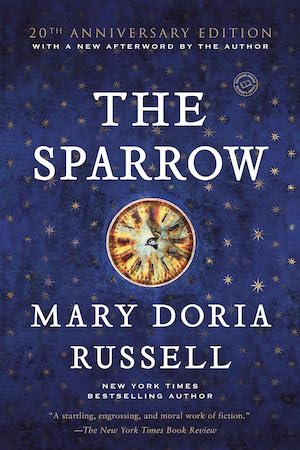

The Sparrow
AI is coming for your job
When we meet Jimmy Quinn, the young NASA employee who first identifies the alien communication from Rakhat, he’s just been assigned a “vulture”. In the parlance of The Sparrow’s version of 2019, a “vulture” is basically a human AI scraper: a person who interrogates a specialist about the inner workings of their job to see how much of it, if any, can be encoded and turned over to machines. If it works, that specialist and their fellows are out of work. Because of that, vultures are not particularly well-liked.
Private interests… in… spaaaace
In the 2020s of The Sparrow, mining corporations (mostly Australian for some reason?) have begun harvesting and mining asteroids. Once an asteroid is partially hollowed out, a corporation with enough money could, theoretically, use the husk as a ship for space exploration. This is precisely what the Jesuits do, sending Emilio and his crew to Rakhat on a privately funded mission that doesn’t have to answer to any particular government or even the UN. Soon thereafter, at least one private firm called “the Contact Consortium” also sends an asteroid, more interested in establishing trade with the people of Rakhat than in the “Science, with, perhaps, a small scoop of proselytizing” mission that the Jesuits organized.
Portable digital reading devices
Russell doesn’t make a big deal out of it, but in the 2016-2019 sections of the book, everyone seems to use “tablets”, which I can only see as a flat portable reading device like an iPad, which people can write on directly using stylus. In the 2060 section, the (I assume updated) version is called a “notescreen”, and at one point someone leaves “an old ROM periodical” out for Emilio, who’s 40 years behind the times. None of these tablets are referred to by brand names, and they seem to be able to connect to the internet, referred to solely as “the net”, without anyone making a big deal about wires or wifi.
And about that “net”
At a pivotal point, one character tells another to “get on the net” and they reply “No, virtual reality isn’t good enough, I want reality reality”—which implies that there are video chatrooms available for people to share, à la our current use of Zoom and Google Meet. There is also a moment when one character pays extra to make an important videocall to his friends rather than settle for a regular telephone call.
Normcore?!!
I’ll admit this is a little bit of a stretch. In 2015, a few years before the mission to Rakhat, Father Emilio Sandoz is sent to work with a vulture in Cleveland. He meets the woman in a coffeeshop near the college campus, and is struck by the fashions of the youth, which is made particularly noticeable because he’s been working at a refugee camp at the edge of a war zone for a year. He looks at the sea of young people:
“…the young men in brilliantly colored, intricately pleated coats that broadened shoulders and narrowed hips, the young women wasp-waisted and delicious in pale and shimmering fabrics the colors of peony blossoms and sherbet.” (34)
When I revisited the book recently, I was struck by the similarity to the fashions of 2013’s Her, set in a near-future, which itself tapped into the then-popular style known as normcore.
HIV is no longer a death sentence
A few pages after the invention of Normcore, and still firmly in 2014, Sandoz makes a passing mental reference to people with “chronic HIV”. Meanwhile HIV was still the #1 cause of death for young Americans in the 1990s, and by 1996 HIV was only barely treatable, with complicated drug cocktails that could hold AIDS at bay for varying amounts of time, but which were no guarantee of a long life. But by the early 2010s better cocktails and PrEP became increasingly available, matching Russell’s timeline almost exactly.
But Russell didn’t get everything right, and I picked out three things in particular that she missed.
Whither Television?
When Emilio’s friend George Edwards meets freelance vulture Sofia Mendes in 2019, he’s unsure of her age, and wonders if she’s too young to remember TV. It turns out that she’s 29 at that point, which would mean she was born in 1989/90. Even if we want to say that The Sparrow is an AU, I find it fascinating to think that someone the same age as Taylor Swift wouldn’t “remember” TV—did all network television simply die out in the early ‘90s? Because people know movies! Emilio seems to have a surprisingly thorough knowledge of films that would have been old when he was a kid, and there are a weird number of references to Young Frankenstein scattered throughout this book. So how were people watching these movies if no one had TV anymore? But it is worth noting that when people gather together in the book, it’s always either at bars, or for dinner parties. There are no movie marathons, no Oscar parties, no Sunday afternoons in front of a baseball or fútbol game.
And furthermore, where are the cellphones?
There aren’t any! As I was reading the book again something kept nagging at me, and I finally realized that no one in the book carried a phone on them. They made calls from landlines, and sent messages—video and text—over the internet, but there was no indication that any company had made the now-obvious jump to selling pocket computers that are also phones. As a person who was a late cellphone adopter—I think I held out until 2005—this was an eerie glimpse into a different world where we could walk away from the internet, our jobs, constant contact with everyone we’ve ever known… but also got lost more often, I guess.
And finally…
We actually did something about climate destruction???
In 2019, Emilio lives in a free apartment because it’s so close to the coast no one else is brave enough to live in it, implying that the sea levels are rising pretty rapidly. However, in the 2060 sections we learn that, at least in Italy, wood fires are illegal (a priest wonders if the next Papal Election will be announced via a digital sign reading “White Smoke” rather than using actual smoke) and private vehicles aren’t allowed inside city limits. Russell makes a point of mentioning the various plants blooming over a few months’ time in the books to mirror Emilio’s slow healing process, but it also shows us that plants are thriving in a future that, seemingly, halted climate destruction. There are also still bees!
That’s what I found on my most recent re-read—for those of you who have read the book, did I miss anything that jumped out at you? What are your favorite literary futures? And will we ever live in a future where The Sparrow is adapted to TV, in whatever form that medium exists? [end-mark]
Wicked’s Jonathan Bailey May Trade Witches for Dinosaurs in the Next Jurassic World Film
Published on April 16, 2024
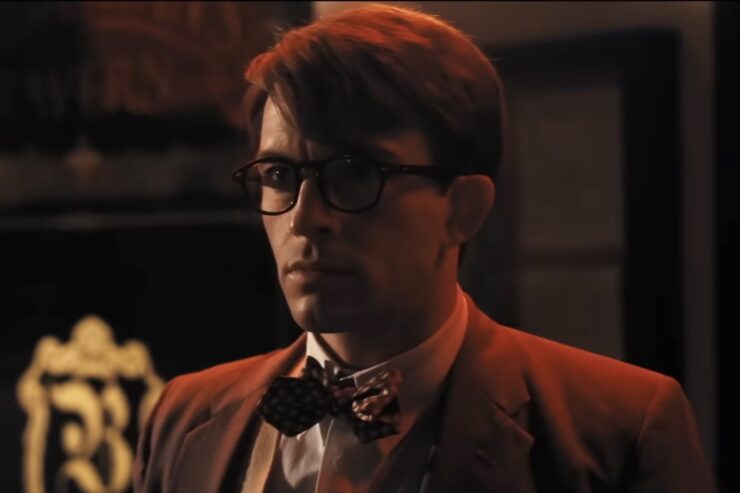
The dinosaur movies will continue until morale improves? Wait, that’s not quite how the saying goes. At any rate, the cast is beginning to form for the eventual next movie in the Jurassic World franchise, which has Rogue One’s Gareth Edwards as director and a script from original Jurassic World screenwriter David Koepp. It’s not yet known what the story is about, or who the characters are (though they are expected to be all-new), but Scarlett Johansson will hopefully trade her Black Widow costumes for some practical footwear as one of the leads.
And maybe her costar will sing to the dinosaurs? Deadline reports that Jonathan Bailey—of Bridgerton and the impending Wicked—is in talks to star alongside Johansson. One hopes, for the director’s sake, that they talk quickly, as these dinos are expected to hit the big screen next year, which is not really all that long from now.
Bailey is also known for the recent miniseries Fellow Travelers (pictured above) and, some years back, Broadchurch. He may not quite be as well-known as Johansson, but the two parts of Wicked may make him something more of a household name.
The as yet untitled Jurassic flick is expected to hit theaters July 5, 2025. [end-mark]
A Different Type of Romance: Someone You Can Build a Nest In by John Wiswell
Published on April 17, 2024
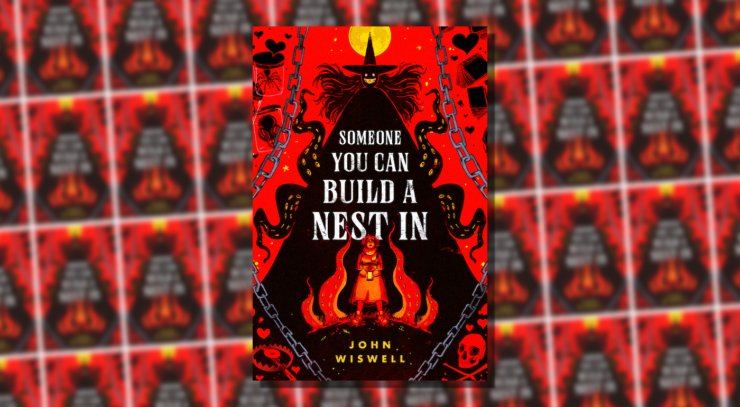
All Shesheshen wants is to hibernate in peace, play with her wild blue-furred bear, and occasionally feed on an unsuspecting human. But no, the Wulfyre family will not leave her alone. After an attack, goo-based Shesheshen shapeshifts into human form and is rescued by Homily. She is an odd woman who, in spite of everything, finds Shesheshen amusing. The monster who isn’t very good at being monstrous and the maiden who is neither pure nor innocent make a surprisingly good match. So much so that Shesheshen comes to the realization that not only is Homily the perfect person to lay her eggs in but that she’ll die as a result.
Soon, the two women are dragged into the Wulfyre hunt for the wyrm (aka Shesheshen in her monster form), and all kinds of terrible things emerge from the shadows. If they want a chance at happiness together, a lot of bad people are going to have to die first. But those bad people also want them dead. Whatever happens next, it’s going to push Homily and Shesheshen to the brink.
This is one of those novels that is probably going to be a challenge to sell. I’m already seeing people calling it “cozy horror” and “romantasy”. While there are some horrific elements—lots of gore and body horror, albeit expressed in practical rather than horrifying ways—and there is a romance subplot, evoking those genres can lead readers to expect certain tropes and vibes. I’d put this squarely into general fantasy rather than one of the popular new marketing terms. It’s weird and unsettling, and it plays with elements of horror and romance without fully committing to those genres.
Buy the Book
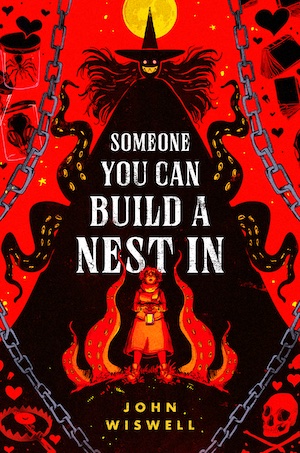

Someone You Can Build a Nest In
I think it’s also important for readers to come prepared for queer shit. Not just queer as in LGBTQIAP+, but queer as in rejecting the norm, the traditional, and the socially acceptable. Queer as in revolutionary. Queer as in “fuck you and the assumptions you rode in on.” Shesheshen and Homily’s relationship is queer, as is the way Shesheshen interacts with the world. Remember: Shesheshen is a monster both literally and metaphorically. Her very existence violates social norms. She can “pass” as “normal”, or mask, if you will, but only by mimicking other people and practicing their behaviors. I’m neurodivergent and so much of Shesheshen’s experiences felt eerily familiar. The pragmatism, the frustration at not being able to figure out what someone actually wants versus what they say they want, the feeling like you’re pretending at being a certain kind of person when you’re really something else entirely. At times, she is overwhelmed by sensations that humans don’t seem to notice, and she reacts to things in a way that some humans would find cold and emotionless but is for her just the logical response to an illogical situation.
Something else that makes you feel monstrous? Being on the asexual and aromantic spectrums. Before I knew those words, I thought I was a broken person. I couldn’t understand attraction, so I had what I called practice boyfriends; maybe sex and love were like practicing the piano, and if I just dated enough someday it would all make sense. I felt unloved, unloveable, and unloving. I felt like I was playing at being a person. I felt alien and wrong. It took three decades for me to find asexuality and aromanticism, but it only took a few moments (and reading Julie Sondra Decker’s The Invisible Orientation) to realize I wasn’t broken, just shaped differently. Like Shesheshen, I also went through a metamorphosis where I could finally see myself for who I truly was. It wasn’t me who was wrong but the expectations the world put on me. I could live my life in a way that was satisfying and enjoyable to me. Let the allos be confused and uncomprehending for once. I know who I am.
Trauma and abuse can also make you feel like a monster wearing a person suit. Homily had a lifetime of torment at the hands of her family. She grew up feeling insignificant and unvalued. She felt unworthy of things other people took for granted. She was a thing to be used and pushed around, not a person who deserved support and protection. Coming out the other side of abuse means dealing with the resulting trauma. You basically have to shape yourself into a living person while cutting out all the things that are holding you back. But you can never quite get free of all those horrors.
So while yes, Someone You Can Build a Nest In is romantic, it’s an aromantic version of romance rather than an alloromantic one. I might even call it queerplatonic. Whatever it is, it’s hella queer. And that romance is also colored by Shesheshen’s neurodivergence as well as Homily’s trauma. Don’t come into this novel expecting allo-tinged tropes. And if this is your first exploration into the wild lands of asexuality and aromanticism, welcome. We do things differently around here.
The only real miss for me was the predictability of the plot. The plot was not nearly as inventive as the premise was. Part of that was the epilogue. It felt a bit like cheating, like Wiswell got to have his titular nest without all the accompanying violence. Maybe that was the point, or maybe the point was to do what Romance novels often do and flash forward to see how that HEA/HFN is going. I don’t know, but I’m not convinced it was necessary.
With his typical quirky humor and creative wit, John Wiswell’s debut novel Someone You Can Build a Nest In is a winner. I’ve been looking forward to his move from short to long fiction for a while now, and he did not disappoint. Aces and aros, this one is for you. [end-mark]
Someone You Can Build a Nest In is published by DAW.
Read an excerpt.








